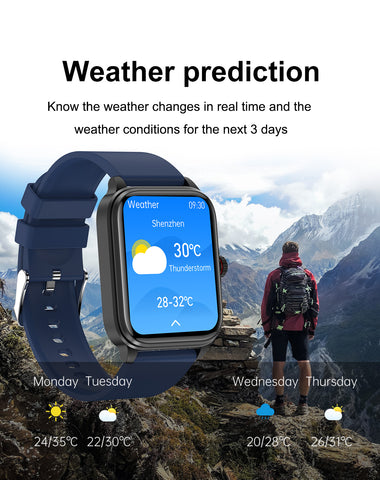Smart Fitness Watch
Have you decided whether to hire a coach? Regardless of whether you have hired a coach or not, the most important priority for fitness beginners is to first determine the appropriate "fitness goals" based on your physical condition, age and body shape, so that you can effectively set a training plan for your goals! Follow the steps below to establish your goals step by step!
STEP 1. Examine age stages: before and after 30 years old
Before age 30:
When you are in your 20s, your body is in peak condition. You can set some challenging goals and train hard. The earlier you start fitness and improve your muscle strength, the better the training effect will be. When you leave your 20s and enter your 30s, your body gradually moves away from its peak state and the recovery speed may also slow down. If you want to maintain a high level of health, you need to pay more attention to arranging adequate rest time and nutritional supplements.
After 30 years old:
The age of 30 is the first aging slope in life. Muscle mass and bone mass will begin to decline. In order to prevent osteoporosis in the future, both men and women should start fitness at this time at the latest (here refers to "weight"). "Training" (weight training) to improve muscle strength and keep the body healthy. Research points out that the process of weight training puts stress on bones, telling tissue cells to take action and make bones stronger. Therefore, the earlier you start exercising, the more you can reduce the risk of osteoporosis, fractures and falls. As you age, the risk of sports injuries increases. At this time, it is recommended to find a professional coach to accompany and guide you to ensure safety!
STEP 2. Determine fitness goals: lose fat, gain muscle, maintain body shape
Fat loss:
Fitness is one of the ways to create a caloric deficit (Calorie Deficit), which can help burn calories. The so-called caloric deficit, also known as caloric gap or caloric deficit, means that when the human body "takes in calories < consumes calories", the body will burn the original calories in the body to generate energy, thereby achieving the goal of losing fat. Studies have found that increasing muscle mass through fitness can increase metabolic rate, allowing you to burn more calories and create a larger caloric deficit. When combined with appropriate eating habits, it can effectively reduce body fat rate.
Build muscle:
Building muscle through fitness is a process of "increasing muscle mass", adding firm and powerful muscle lines to the body and increasing physical strength. As muscle increases and fat decreases, the body will look slimmer. This is because muscle is denser than fat and takes up less space per kilogram of body weight. Therefore, after exercising, the number on the scale may not change, but the waist circumference has decreased. If you want to lose weight, you can also arrange to lose fat first and then gain muscle, which can effectively make your body slimmer.
Stay in shape:
Fitness can target specific parts to sculpt your body and improve your body shape. For example, boys may want to build their abdominal muscles, and girls may want to build their buttocks. These can all be achieved through training! The human body can be roughly divided into: upper body (chest, shoulders, neck, upper back, arms), trunk (abdomen, lower back), lower body (feet, buttocks). You can first think about which part you want to improve to set a training plan. Paint to make your body look more toned.
STEP 3. Set short-term and long-term goals
After reviewing your current age and confirming what you want to achieve with fitness, the next step is to set personal fitness goals! Goals should include short-term goals (approximately 1 week to 6 months) and long-term goals (approximately 6 months to 1 year), and short-term goals should promote the achievement of long-term goals. In addition, when defining your goals, set a time frame and make sure there are measurable units (such as body fat percentage) so that you can review your progress later. Here is a simple example:
Short term goals:
- Within a week, arrange 3 sets/12 sit-ups on four days.
- Pick a month and replace one of your meals with a salad every day.
- In the two weeks before your workout, try every piece of weight-lifting equipment at your fitness center.
Long-term goals:
- Drop body fat percentage to 20% in eight months.
- Able to bench press 180 pounds in one year.
Once you’ve set your goals, it’s time to start exercising! Wearable technology can effectively assist exercise by monitoring various body data, making your exercise more visual and safer!













